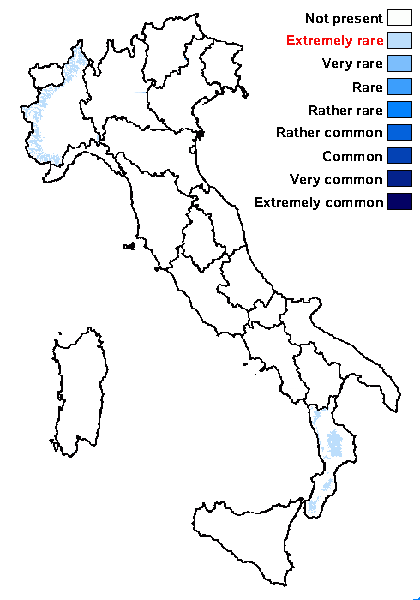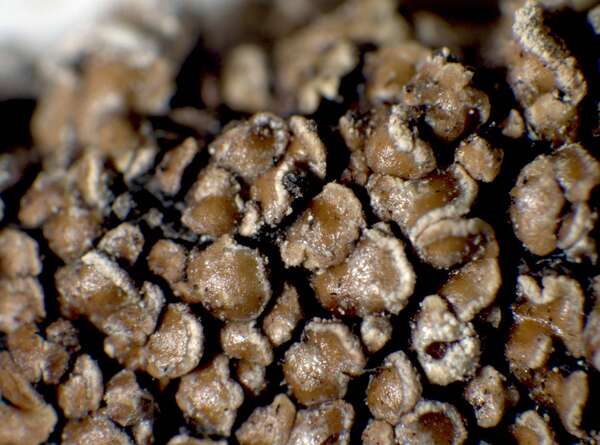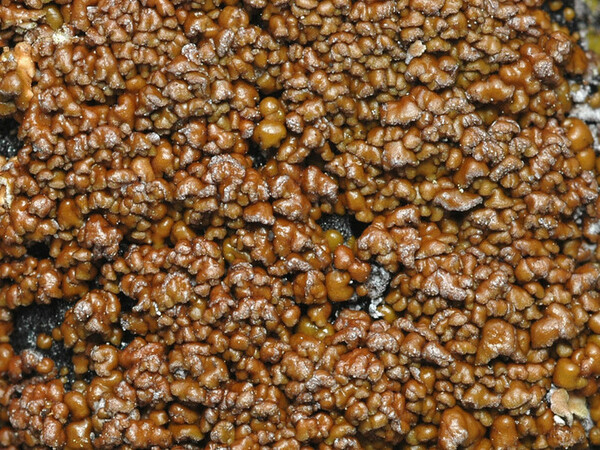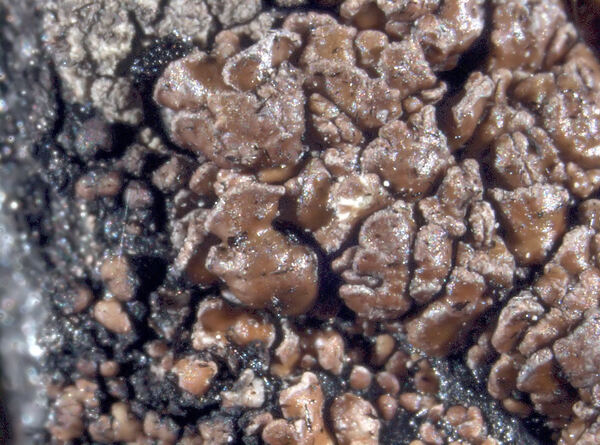Carbonicola anthracophila (Nyl.) Bendiksby & Timdal
Taxon, 62: 950, 2013. Basionym: Lecidea anthracophila Nyl. - Flora, 48: 603, 1865.
Synonyms: Biatora anthracophila (Nyl.) Hafellner; Hypocenomyce anthracophila (Nyl.) P. James & Gotth. Schneid.; Lecidea cladonioides Th. Fr.; Lecidea cladonioides var. albocervina (Räsänen) Zahlbr.
Distribution: N - Piem (TSB 25768). S - Cal (Puntillo 1996).
Description: Thallus squamulose grey-green, greenish brown to medium brown, shiny, sorediate. Squamules up to 0.8(-1.3) mm wide, ascending, geotropically oriented, at first weakly concave or flat, later convex, with a slightly upturned, whitish to pale brown, sorediate margin. Soredia grey, farinose to granular, arranged in marginal, labriform soralia. Cortex up to 130 µm thick (including an up to 70 µm thick epinecral layer), of thick-walled hyphae with very narrow lumina; medulla white, I-. Apothecia rare, lecideine to biatorine, up to 0.8(-1.3) mm across, mainly marginal or developing on the underside of squamules, with a reddish brown to dark brown, convex, epruinose disc, and an entire, more or less prominent, soon excluded proper margin. Proper exciple of closely conglutinated, thin-walled hyphae with ellipsoid to short-cylindrical lumina, pale brown in outer part, colourless within, without crystals, K-, N-; epithecium brown, K-, N-; hymenium colourless, 40-50 µm high; paraphyses sparingly branched and anastomosing, 2-2.5 µm thick at mid-level, the apical cells swollen and dark-capped; hypothecium colourless. Asci 8-spored, clavate, without an apical amyloid cap, with a well-developed, amyloid tholus containing a deeper amyloid tube. Ascospores 1-celled to (rarely) 1-septate, hyaline, narrowly ellipsoid to fusiform, 7-13 x 1.5-2.5 µm. Pycnidia sessile, black, mostly marginal, with a brown wall, N-. Conidia filiform, slightly curved, 6.5-12.5 x c. 1 µm. Photobiont chlorococcoid. Spot tests: cortex K-, C-, KC-, P+ red, UV-; soralia and medulla UV+ blue-white. Chemistry: fumarprotocetraric acid, protocetraric acid, colensoic acid, 4-O-methylphysodic acid and related compounds.Note: a circumboreal-montane lichen found on charred wood in upland areas. It is included in the Italian red list of epiphytic lichens as “Endangered” (Nascimbene & al. 2013c).
Growth form: Squamulose
Substrata: lignum
Photobiont: green algae other than Trentepohlia
Reproductive strategy: mainly asexual, by soredia, or soredia-like structures (e.g. blastidia)
Commonnes-rarity: (info)
Alpine belt: absent
Subalpine belt: extremely rare
Oromediterranean belt: absent
Montane belt: extremely rare
Submediterranean belt: absent
Padanian area: absent
Humid submediterranean belt: absent
Humid mediterranean belt: absent
Dry mediterranean belt: absent

Predictive model
Herbarium samples
Growth form: Squamulose
Substrata: lignum
Photobiont: green algae other than Trentepohlia
Reproductive strategy: mainly asexual, by soredia, or soredia-like structures (e.g. blastidia)
Commonnes-rarity: (info)
Alpine belt: absent
Subalpine belt: extremely rare
Oromediterranean belt: absent
Montane belt: extremely rare
Submediterranean belt: absent
Padanian area: absent
Humid submediterranean belt: absent
Humid mediterranean belt: absent
Dry mediterranean belt: absent

Predictive model
| Herbarium samples |
 Index Fungorum
Index Fungorum
 GBIF
GBIF






